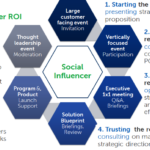When you think of banks, or any financial institution for that matter, I doubt you are overcome with heartwarming images of improved welfare and social care. Unless you’re among the few that have had a warm and fuzzy experience, most likely your relationship with your bank is mainly transactional — a deposit made here or statement issued there. Interestingly, there is at least one bank out there that would like you to like them less for their transactional prowess and more for their commitment to “bringing the age of opportunity to everyone.”
That bank is BBVA Compass and the campaign that got my attention is called “Banking on a Brighter Future,” a purpose-driven program introduced
by their Chief Marketing and Digital Sales Officer Jennifer Dominiquini. I’ve known Jennifer through The CMO Club for several years and was delighted when we finally had a chance to talk about purpose-branding and the organizational commitment required to make it real. Jennifer, as you will soon see, is not one to just talk the talk. She also walks the walk or more precisely rides the ride, having just completed a 500-mile bike trip for a charity that was also a BBVA customer. So yes, her commitment to living bright and giving a chance for others to do the same is something you can bank on!
Note: this is a lengthy interview but I decided not to break it up into 2 posts because frankly if you are interested in how to activate effectively against your brand purpose, you’ll want to read every last word.
Drew: Can you take me back to when you became a purpose-driven organization and the process that you went through to determine your purpose?
Jennifer: Since its founding in 1857, this company has believed its corporate purpose should be about creating a better future for people. Recently, our Chairman and our CEO realized that we needed to make it more explicit that we are a purpose-driven organization, and so last year we set out to do just that by specifically stating that our purpose is to bring the age of opportunity to everyone.
The company overall is very inclusive, and that has led us to facilitate opportunity for everyone, whether an individual, a family, a company, or a community. Said another way, we believe everyone deserves a bright future and the chance to thrive in the age of opportunity. Our goal as an organization is to help our clients stay in control of their financial journeys, and it is our responsibility to help them get to that bright future.
Drew: Was the idea of “Banking on a Brighter Future” developed in-house or did you work with an agency partner?
Jennifer: It was actually developed in-house with the support of agency partners. One of the key inspirations was our global purpose statement, which aligned perfectly with the traditional brand research we had. We were really passionate about this, so we put it into practice first by rolling it out internally and then started to incorporate it in our external messaging as well.
Drew: How did you communicate the idea of “Banking on a Brighter Future?”
Jennifer: We tried to infuse as much “bright” vocabulary into the work we were already doing internally. We also ensured that every element of our end-to-end client experience was bright. We highlighted bright moments of associates out in the field who went the extra mile to help a client. At our employee launch, our CEO and key leaders hosted a fireside chat-style forum to share the brand strategy and communicate the message hat every associate has the responsibility to bring the brand to life. We wanted all employees to understand that this was not just a new tagline but rather a way of doing business, a way of living and breathing the brand.
Drew: How did you equip employees with the resources needed to promote the brand externally?
Jennifer: First, we incorporated the word “bright” into our different methods of communication as often as we could. We also created an employee brand portal with videos and other media, showing how our executives were embracing the brand and also branding themselves. We distributed bright blue boxes containing stickers and other brand paraphernalia to each department so employees could display and promote the brand.
In order for the brand launch to be successful, it had to be something our associates believed enough they would be willing to go out and share it. So, a few months later after our internal launch, we celebrated our first annual Bank It Forward Day, a chance for our associates to bring the brand to life in the community through random acts of kindness.
Drew: Can you provide an example of how employees went out into the community, promoting Bank It Forward Day?
Jennifer: We equipped everybody with the opportunity to volunteer and do random acts of brightness in the community. Essentially, employees formed groups of 5 to 10 people, then went out and did acts of kindness in the community using their $25 gift cards provided by BBVA Compass. That was the first real opportunity for our employees to realize that when you live bright, you can actually have fun while helping out others in the community. Some of the stories were just phenomenally engaging, and we generated social media buzz and plenty of employee engagement as a result.
Drew: Can you give a few examples of some of these “acts of brightness?”
Jennifer: We saw one person pay off a debt for a family whose son was in the hospital. We also met a woman who had a couple of flat tires on her car but had to leave it to feed her baby at home. When she came back, she saw the note on the car that said, “It’s BBVA Compass. Come on over, we’d love to help and we have a surprise for you.” A few associates combined their gift cards to buy the woman four new tires for her car.
I personally had the honor of surprising a shopper in a grocery store who was about to spend her last $20 of the week. I think the tipping point in the brand roll out was when employees started to have fun. They realized this is not just a marketing strategy exercise, this is a way of living.
Drew: Do you have a sense of what percentage of employees participated? Did you have a goal?
Jennifer: This was one of our most successful volunteer outreaches ever. We started at 12% the first time, and now we’re up to 30%. This time, the updated program – now called 100 Days of Brightness – extends beyond a single day to give employees the flexibility to choose any day over the course of 100 days.We were really impressed the first time because we really didn’t know what would happen but 98% percent of the people who participated said they would absolutely do it again.
Drew: What was the reception of the Bank it Forward initiative” among senior BBVA Compass executives?
Jennifer: Our executives have been extremely supportive of this because, as a company, they all understand that we can’t just talk about our purpose, we have to go out and fulfill it. For example, the Head of Business Development is an avid runner, so he ran around a park on Father’s Day and surprised other park runners with gift cards. He also visited one of our charitable partners along his route to surprise them with more gift cards.
Our COO, who is very much supporter of animals, visited an animal shelter to deliver much-needed supplies for the shelter. And our CEO pursued his passion for helping children by bringing a cool treat to kids at the Community Family Center in Houston. In addition to some new sports equipment and art supplies, he also served snow cones to nearly 200 students and staff on a hot July afternoon.
Drew: So have you changed or adjusted your hiring practices to emphasize brightness among candidates?
Jennifer: People are definitely looking to bring in others with a like-minded, positive energy. We aim to on-board people who share our purpose-driven methodology and look for ways to empower people to act brightly across our employee base.
Drew: How did you go about making employees feel comfortable to bank at BBVA?
Jennifer: As our CEO said, if we are going to talk about brightening the lives of others, we also need to do a good job of brightening the lives of our teammates. We emphasize our employee banking perks and make sure people take advantage of the benefits of being loyal to your employer. We’ve done a lot of employee banking drives to encourage people to sign up, and those events provide the perfect opportunity to remind employees why they should bank where they work. It’s more than just a reminder that each account benefits the company. It’s a reminder that, when you bank the brand, it’s easier to successfully live the brand and share it with others.
That said, we need to make sure it is easy and rewarding for those associates to bank with us, – for both clients and employees alike.
Drew: So we spent most of our time on internal activation, is there anything that you would like to highlight from an external standpoint?
Jennifer: Absolutely. We knew we had hit a home run internally, so we wanted to make sure our external push was equally successful. We created an online portal for our video content, and because we are official bank of the NBA, we were able to launch Bright Futures externally in a robust way.
Our brand ambassadors tell their own personal stories to bring to life the ten Bright Futures principles. For example, Becky Hammon, the first female coach in the NBA, talked about the hurdles she faced on the road to becoming an all-star player and the first female All Star coach. Instead of telling the athletes’ stories from the sports angle, these videos really captured the human angle.
Drew: What is the reason behind the sports focus of Bright Futures?
Jennifer: We started with sports because that’s where many of our sponsorship lie (we are the official bank of the NBA and the Houston Dynamo and Dash call the BBVA Compass stadium their home) but as I said, we intend to expand it to a lot of different walks of life. Ultimately we will feature musicians and artists, technology, entrepreneurship and other areas.
We’ve also incorporated the Brighter Future mantra into nearly all our external marketing. From a social media perspective, we engage our audience with our #LiveBright and #BrightFutures hashtags. The two work well together because we’re saying if you want to help others have a bright future, then you have to live bright along the way.
Drew: It’s fascinating to hear you talk about how you shifted from product-first to story first, which must have sparked a good amount of doubt and discomfort internally. What made you confident that this risk was worth taking?
Jennifer: Well, we still do free-checking and rate-based advertising for our deposit products, and we still promote our loan products. But we’ve tried to layer acquisition marketing, digital marketing, and branded advertising with messaging that’s consistent with the brand, using the video and the storytelling piece. The brand, the content, and the storytelling have enabled us to improve our consideration scores with consumers, to bring new clients to the bank and to engage our existing ones.
Drew: We’ve heard about the successes of the Bright Future initiative but I’m guessing there have been some mistakes along the way? Can you tell about some of the challenges you have encountered?
Jennifer: I would say that there have been definitely some creative executions that didn’t work as well in the beginning. Creative development for us was an iterative process, and we learned what resonated and what didn’t as we experimented and iterated based on learning. The good news with digital is that it’s easy to do a lot of testing, but part of our initial challenge was aligning the right creative with the right media and doing so in a nimble and flexible way. I don’t think it was a failure, but more of a learning process and a recognition that some efforts don’t produce immediate results.
Drew: You’re the Chief of Marketing and Digital Sales Officer. Do those two often conflict?
Jennifer: Not really. Digital has been a major focus to drive sales through all of our channels, along with improving the branch experience and engaging our clients. In fact, all of the key marketers in other countries in the BBVA portfolio also have this title. I’m lucky that I don’t just own marketing, but I actually have online account origination and analytics which allows me to see much more of the end-to-end experience.
Drew: I know you’re heavily focused on digital but how much of your role is centered on traditional marketing?
Jennifer: In the old days, marketing was very much “put the product over the fence and tell the clients what they need to know.” Historically, digital and traditional marketing have been separated. But having these two areas together is fundamental because I have the flexibility to allocate resources between digital and traditional efforts. We recognize that it can’t all just be about digital. There are many times when more traditional marketing like direct mail or newspaper ads make the most sense; in other cases, we know that branded content on YouTube will be more widely watched that television. Having ownership of both sides lets us leverage the best channel for each initiative. All in all, it’s been a very interesting time to be a marketer and the fact that I have both of these sides is wonderful.
Drew: Now, you have to tell us about your 500 mile bike ride. What a great example of how you are living the brand purpose.
Jennifer: Well, it was the experience of a lifetime seeing our client, David Baldwin, literally ride from coast to coast. The trip really encapsulated living bright: everybody was happy, helping each other, and teaching each other. It was very powerful to know that we were doing something for a good cause, and that we were able to put ourselves literally our client’s shoes. The Pursuit ride raised $12.5 million for the Center, a private, not-for-profit organization caring for adults with intellectual and development disabilities, while raising awareness for adults with disabilities nationwide. Baldwin rode 3500 miles, and BBVA Compass was proud to be the ride’s presenting sponsor. The event aligned perfectly with our belief that that everyone deserves a bright future. I could not be more proud of riding alongside David and team. As the Chief Marketing Officer, it is my responsibility and honor to not only shape the brand but believe in it and live it, too.
 When SAP acquired Ariba a few years back, newly appointed CMO
When SAP acquired Ariba a few years back, newly appointed CMO  In the last few years, a number of brands have realized that to earning the trust of consumers isn’t something they’ll be able to accomplish on their own. The reality is that people trust people more than brands, which explains the emergence of influencer marketing. Instead of going straight to their target market, brands are now looking to a chosen few individuals to augment their message and promote their products. Influencer marketing programs have stepped boldly onto the scene and have set up shop in B2C and B2B environments.
In the last few years, a number of brands have realized that to earning the trust of consumers isn’t something they’ll be able to accomplish on their own. The reality is that people trust people more than brands, which explains the emergence of influencer marketing. Instead of going straight to their target market, brands are now looking to a chosen few individuals to augment their message and promote their products. Influencer marketing programs have stepped boldly onto the scene and have set up shop in B2C and B2B environments.